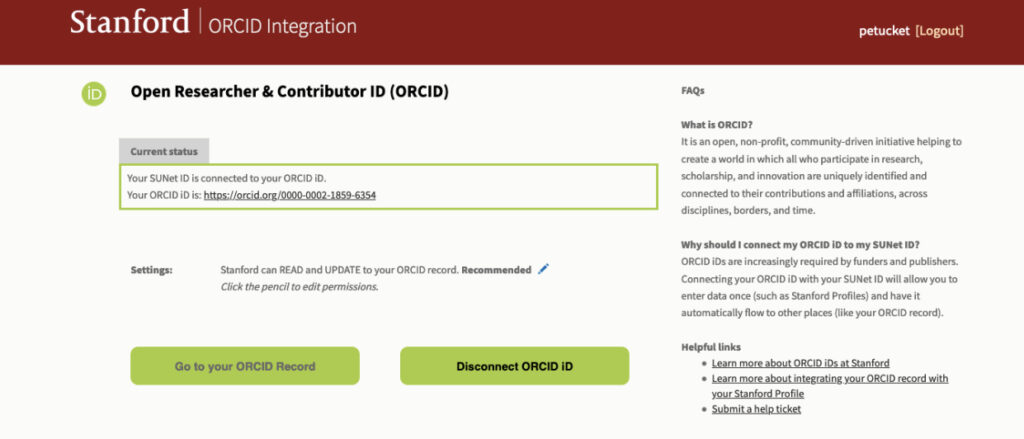Stanford University became an ORCID member in 2016 through the NorthEast Research Libraries consortium (NERL), subsequently joining with the ORCID US Community in 2018.
With enthusiastic support from the libraries and research office, the use of ORCID iD (Open Researcher and Contributor Identifier) by Stanford researchers has been promoted for several years as a best practice throughout the research lifecycle and for bolstering digital identity in the scholarly communication ecosystem. Endorsement of ORCID has reached a new level through a vote by the Stanford University Faculty Senate. In November 2020, the Senate voted overwhelmingly to pass a resolution in support of ORCID iD adoption for all members of the Academic Council (primarily faculty & senior fellows), as well as establishing an Office of Scholarly Communication and prioritizing Open Access initiatives. The new academic policy on adoption of ORCID states:
“Each member of the Academic Council will obtain an Open Researcher and Contributor Identifier (ORCID ID), with assistance provided as necessary by the Stanford Libraries.”
This resolution stems from an earlier vote to recommend adoption of ORCID iDs from the Stanford Faculty Senate Committee on Academic Computing Information Systems (CACIS). Tom Cramer, Associate University Librarian & Director of Digital Library Systems & Services, shared insight on this first CACIS vote in our previous blog on institutional endorsement of ORCID.
Earlier in 2020, Stanford completed a custom ORCID API integration with their central SUNet identity database, allowing researchers to connect their ORCID iD with Stanford, authorizing Stanford University as a trusted organization.

With exemplary cross-campus communication and collaboration through an inter-departmental ORCID working group involving representatives from the library, research office, and others at the University involved with ORCID adoption and outreach, Stanford has since taken their custom ORCID API integration further by displaying authenticated ORCID iDs on Stanford Profiles pages, with the ability to transfer works and other relevant information between Stanford Profiles and ORCID.
The ORCID iD connection is confirmed upon user authorization; users may edit their “read” and “update” permissions in the Settings panel.
Stanford Libraries has also recently released a new online deposit application for their digital repository, the Stanford Digital Repository, that includes an option to include ORCID iDs for individual authors and contributors. The application is designed for use by campus researchers for preservation and sharing of scholarly outputs of all kinds, as well as by library staff for digital collections. Users of the application can choose to enter authors via an ORCID iD. The application then uses the ORCID API to retrieve author name information, which can then be modified by the user for display on this particular work (no changes are made to the ORCID record).
Online deposit application for the Stanford Digital Repository includes an option to enter ORCIDs and automatically retrieve name information for the deposit.
Many thanks to the Stanford team for sharing their story! For more information about ORCID at Stanford, contact orcidus@lyrasis.org.

